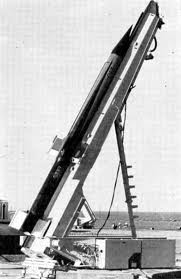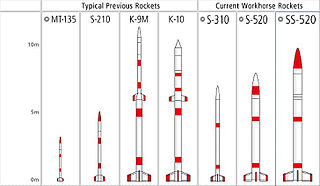
A reusable launch vehicle has parts that can be recovered and reflown, while carrying payloads from the surface to outer space. Rocket stages are the most common launch vehicle parts aimed for reuse. Smaller parts such as rocket engines and boosters can also be reused, though reusable spacecraft may be launched on top of an expendable launch vehicle. Reusable launch vehicles do not need to make these parts for each launch, therefore reducing its launch cost significantly. However, these benefits are diminished by the cost of recovery and refurbishment.

Vostok was a family of rockets derived from the Soviet R-7 Semyorka ICBM and was designed for the human spaceflight programme. This family of rockets launched the first artificial satellite and the first crewed spacecraft (Vostok) in human history. It was a subset of the R-7 family of rockets.

The N1/L3 was a super heavy-lift launch vehicle intended to deliver payloads beyond low Earth orbit. The N1 was the Soviet counterpart to the US Saturn V and was intended to enable crewed travel to the Moon and beyond, with studies beginning as early as 1959. Its first stage, Block A, was the most powerful rocket stage ever flown for over 50 years, generating 45.4 MN of thrust. However, each of the four attempts to launch an N1 failed in flight, with the second attempt resulting in the vehicle crashing back onto its launch pad shortly after liftoff. Adverse characteristics of the large cluster of thirty engines and its complex fuel and oxidizer feeder systems were not revealed earlier in development because static test firings had not been conducted.

The RL10 is a liquid-fuel cryogenic rocket engine built in the United States by Aerojet Rocketdyne that burns cryogenic liquid hydrogen and liquid oxygen propellants. Modern versions produce up to 110 kN (24,729 lbf) of thrust per engine in vacuum. Three RL10 versions are in production for the Centaur upper stage of the Atlas V and the DCSS of the Delta IV. Three more versions are in development for the Exploration Upper Stage of the Space Launch System and the Centaur V of the Vulcan rocket.

Skylark was a family of British sounding rockets. It was operational between 1957 and 2005.

Bélier is the designation of a French sounding rocket family. Three versions of the Bélier were launched between 1961 and 1970 at the CIEES launch facility at Hammaguir, the Salto di Quirra and Ile de Levant missile ranges, and Kourou Space Center.
The Petrel was a British sounding rocket. The Petrel 1 was launched, like the Skua 1, with 3 Chick booster rockets. The Chick motors were fitted into a Booster Carriage that also carried the two parachutes that brought it back to earth for re-use. The Petrel 1 was 3.34 m long, had a diameter of 19 cm and reached a maximum altitude of 140 kilometres. It was fired from a barrel launcher approximately 60 ft long (18 m).

The Éridan is a two-stage French sounding rocket, which results from the use of the Stromboli engine for the first and second stages.

The Dauphin is a French sounding rocket, flown six times between 1967 and 1979. It consists of a modification of the first stage of the Dragon with a larger payload nosecone.

Centaure was a two-stage French sounding rocket consisting of a Venus first stage and a Belier second stage. It belongs to a family of solid-propellant rockets consisting of the Belier, Centaure, Dragon, Dauphin, and Eridan rockets.

The Uchinoura Space Center is a space launch facility in the Japanese town of Kimotsuki, Kagoshima Prefecture. Before the establishment of the JAXA space agency in 2003, it was simply called the Kagoshima Space Center (鹿児島宇宙空間観測所) (KSC). All of Japan's scientific satellites were launched from Uchinoura prior to the M-V launch vehicles being decommissioned in 2006. It continues to be used for suborbital launches, stratospheric balloons and has also been used for the Epsilon orbital launch vehicle. Additionally, the center has antennas for communication with interplanetary space probes.

S-Series is a fleet of sounding rockets funded by the Japan Aerospace Exploration Agency (JAXA) that have been in service since the late 1960s. Manufactured by IHI Aerospace and operated by the Institute of Space and Astronautical Science (ISAS). The nomenclature of the S-Series rockets is the number of "S"s indicates the number of stages, and the following number details the diameter of the craft in millimeters. For example, the S-310 is a single stage rocket with a diameter of 310 mm.

The Minotaur is a family of United States solid fuel launch vehicles derived from converted Minuteman and Peacekeeper intercontinental ballistic missiles (ICBM). They are built by Northrop Grumman via contract with the Air Force Space and Missile Systems Center's Space Development and Test Directorate (SMC/SD) as part of the Air Force's Rocket Systems Launch Program which converts retired Intercontinental Ballistic Missiles into space and test launch systems for U.S. government agencies.

This comparison of orbital launch systems lists the attributes of all individual rocket configurations designed to reach orbit. A first list contains rockets that are operational or in development as of 2023; a second list includes all upcoming rockets and a third list includes all retired rockets For the simple list of all conventional launcher families, see: Comparison of orbital launchers families. For the list of predominantly solid-fueled orbital launch systems, see: Comparison of solid-fueled orbital launch systems.
TEXUS is a European/German sounding rocket programme, serving the microgravity programmes of ESA and DLR. The launches are conducted from Esrange in Sweden.
The Universal Rocket or UR family of missiles and carrier rockets is a Russian, previously Soviet rocket family. Intended to allow the same technology to be used in all Soviet rockets, the UR is produced by the Khrunichev State Research and Production Space Center. Several variants were originally planned, of which only three flew, and only two of which entered service. In addition, the cancelled UR-500 ICBM formed the basis for the Proton carrier rocket.
The RX rocket family is a series of solid-fuel rockets developed by the Indonesian National Institute of Aeronautics and Space (LAPAN).

A super heavy-lift launch vehicle is a rocket that can lift to low Earth orbit a "super heavy payload", which is defined as more than 50 metric tons (110,000 lb) by the United States and as more than 100 metric tons (220,000 lb) by Russia. It is the most capable launch vehicle classification by mass to orbit, exceeding that of the heavy-lift launch vehicle classification.
The Interarmy Special Vehicles Test Centre (CIEES) (French: Centre Interarmées d'Essais d'Engins Spéciaux) was France's first space launch and ballistic missile testing facility. Outside France, the facility is often referred to by the name of the nearest town, Hammaguir (also called Hammaguira). It was established on 24 April 1947, by ministerial decree as the Special Weapons Test Center (CEES, Centre d'essais d'engins spéciaux) for use by the French Army. In 1948, it was turned over to the French Air Force, who renamed it CIEES. Its remote location in the middle of the Saharan Desert and its relative closeness to the Equator (compared with Metropolitan France) made it an attractive launch site for missiles and orbital rockets.












